

Marzano%20Card1. Best of 2012: Visionaries, Organizations, and Innovations Changing the Way We Learn. Dan Pink: How Teachers Can Sell Love of Learning to Students. By Jennie Rose In his new book To Sell is Human, author Daniel Pink reports that education is one of the fastest growing job categories in the country.
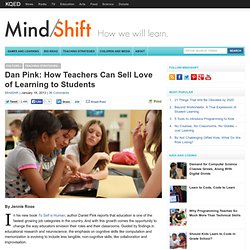
And with this growth comes the opportunity to change the way educators envision their roles and their classrooms. Guided by findings in educational research and neuroscience, the emphasis on cognitive skills like computation and memorization is evolving to include less tangible, non-cognitive skills, like collaboration and improvisation. Jobs in education, Pink said in a recent interview, are all about moving other people, changing their behavior, like getting kids to pay attention in class; getting teens to understand they need to look at their future and to therefore study harder.
Infuential educators. Welcome to Route 21. New Media Consortium Names 10 Top 'Metatrends' Shaping Educational Technology - Wired Campus. A group of education leaders gathered last week to discuss the most important technology innovations of the last decade, and their findings suggest the classroom of the future will be open, mobile, and flexible enough to reach individual students—while free online tools will challenge the authority of traditional institutions.
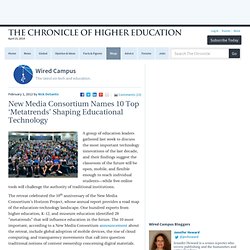
The retreat celebrated the 10th anniversary of the New Media Consortium’s Horizon Project, whose annual report provides a road map of the education-technology landscape. One hundred experts from higher education, K-12, and museum education identified 28 “metatrends” that will influence education in the future. The 10 most important, according to a New Media Consortium announcement about the retreat, include global adoption of mobile devices, the rise of cloud computing, and transparency movements that call into question traditional notions of content ownership concerning digital materials.
Of the top 10 trends the group flagged, Mr. 1. Return to Top. The Key to Learning: A Place for Meaningful Academic Exploration. Projects, portfolios, and presentations rule a school founded on Howard Gardner's theory of multiple intelligences.
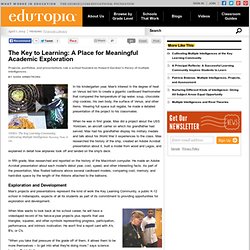
VIDEO: The Key Learning Community: Cultivating Multiple Intelligences Running Time: 9 min. In his kindergarten year, Max's interest in the degree of heat on Venus led him to create a gigantic cardboard thermometer that compared the temperature of tap water, soup, chocolate chip cookies, his own body, the surface of Venus, and other items. Wearing full space suit regalia, he made a detailed presentation of the project to his classmates. When he was in first grade, Max did a project about the USS Yorktown, an aircraft carrier on which his grandfather had served. Emerging_tech03.
Howard Gardner, multiple intelligences and education. Howard Gardner, multiple intelligences and education.
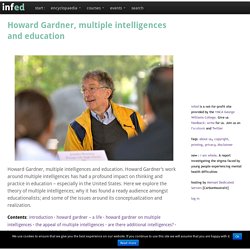
Howard Gardner’s work around multiple intelligences has had a profound impact on thinking and practice in education – especially in the United States. Here we explore the theory of multiple intelligences; why it has found a ready audience amongst educationalists; and some of the issues around its conceptualization and realization. Contents: introduction · howard gardner – a life · howard gardner on multiple intelligences · the appeal of multiple intelligences · are there additional intelligences? · howard gardner’s multiple intelligences – some issues and problems · conclusion · further reading and references · how to cite this article I want my children to understand the world, but not just because the world is fascinating and the human mind is curious.
Howard Earl Gardner’s (1943- ) work has been marked by a desire not to just describe the world but to help to create the conditions to change it. Howard Gardner – a life Mindy L. Structure of Intellect. In Guilford's Structure of Intellect (SI) theory, intelligence is viewed as comprising operations, contents, and products.
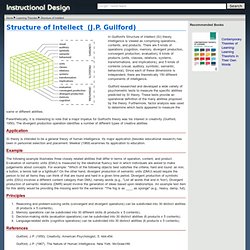
There are 5 kinds of operations (cognition, memory, divergent production, convergent production, evaluation), 6 kinds of products (units, classes, relations, systems, transformations, and implications), and 5 kinds of contents (visual, auditory, symbolic, semantic, behavioral). Since each of these dimensions is independent, there are theoretically 150 different components of intelligence. Guilford researched and developed a wide variety of psychometric tests to measure the specific abilities predicted by SI theory. These tests provide an operational definition of the many abilities proposed by the theory. Furthermore, factor analysis was used to determine which tests appeared to measure the same or different abilities. WhitePaper. Home Page.
21st Century Learning and Teaching. Stephen-harris_virtual-pedagogical-physical-space. Journal of Virtual Worlds Research. Volume 8, Number 2 (2015): Editor in Chief Corner Toward the Futures of Real AND Virtual Worlds Essays Three Real Futures for Virtual Worlds Is a Technological Singularity Near Also for Bots in MMOGs?
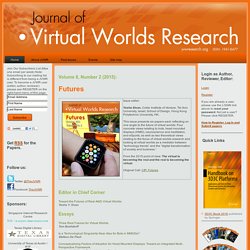
Conceptualizing Factors of Adoption for Head Mounted Displays: Toward an Integrated Multi-Perspective Framework. Harvard Education Letter. Volume 27, Number 4 July/August 2011 Once completely virtual, some K–12 online schools are settling into buildings by Brigid Schulte A student in Miami-Dade County works in a computer lab run by Florida Virtual Schools.
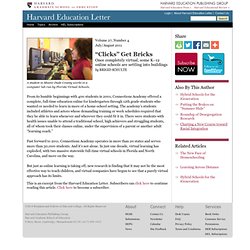
From its humble beginnings with 400 students in 2001, Connections Academy offered a complete, full-time education online for kindergarten through 12th grade students who wanted or needed to learn in more of a home-school setting. The academy’s students included athletes and actors whose demanding training or work schedules required that they be able to learn whenever and wherever they could fit it in.
Fast forward to 2011. Its not chalk and talk anymore: Giving Students Ownership of Learning:Footprints in the Digital Age. November 2008 | Volume 66 | Number 3 Giving Students Ownership of Learning Pages 16-19.

21st Century Learners. Most of us have met them.
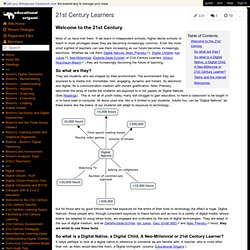
If we teach in independent schools, higher decile schools or teach in more privilaged areas they are becoming increasingly common. Even the more short sighted of teachers can see them increasing as our future becomes increasingly electronic. Whether we call them Digital Natives (Marc Prensky), Digital Children (Ian Jukes), Neo-Millennials (Dieterle-Dede-Schrier) or 21st Century Learners (Sheryl Nussbaum-Beach ) they are increasingly becoming the future of teaching. So what are they? They are students who are shaped by their environment. The Partnership for 21st Century Skills. The Similarities Between Montessori And Digital Learning. The Similarities Between The Montessori And Digital Learning by Carri Schneider first appeared on gettingsmart.com “Before elaborating any system of education, we must therefore create a favorable environment that will encourage the flowering of a child’s natural gifts.
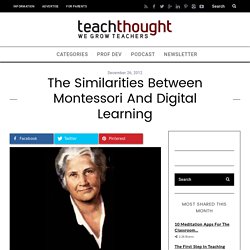
All that is needed is to remove the obstacles. And this should be the basis of, and point of departure for, all future education.” Maria Montessori, The Secret of Childhood, 1936 At first glance, the intersections between Montessori education and high-quality digital learning are not immediately apparent. While a surface look at Montessori learning and digital learning reveals obvious differences, a deep-dive into their undergirding principles reveal a set of very similar core values. How a Multiage Model Made it Possible to Meet 21st Century Goals. Multiage classrooms are not new in the world of education; they have existed from way back into the one room schoolhouse days and open concept schools of the 1970’s. Yet when we accepted the position of teaching a 3-4-5 multiage classroom last year, many questions quickly arose.
How would three different grades be served? Technology, children, schools and families. NextGenv32. This landmark report sets out how the UK can be transformed into the world’s leading talent hub for video games and visual effects. Key findings The education system (including universities and FE colleges) doesn’t provide the skills that the UK video games and visual effects industries need.The stakes are higher than the future of two industries.
The deficiencies uncovered in the education system need urgent action for the future of the UK’s high-tech creative and digital industries more generally.This report’s recommendations include: computer science should be on the national curriculum alongside maths and physics; a GCSE in computer science should be introduced in all schools; and industry-accredited university and FE courses should receive targeted funding from HEFCE as ‘Strategically Important and Vulnerable’ subjects when the Government’s reforms to university education funding are implemented. Authors. Asynchronous_Interactions1. Synchronous_Interactions. Asynchronous_Interactions2. AV_Tools. Ed Tech Crew. Learning Technologies. ASDAN%20summary%20Report. Teachers as Leaders:Ten Roles for Teacher Leaders.
Willing_to_Lead_Leading_Professional_Learning_web.